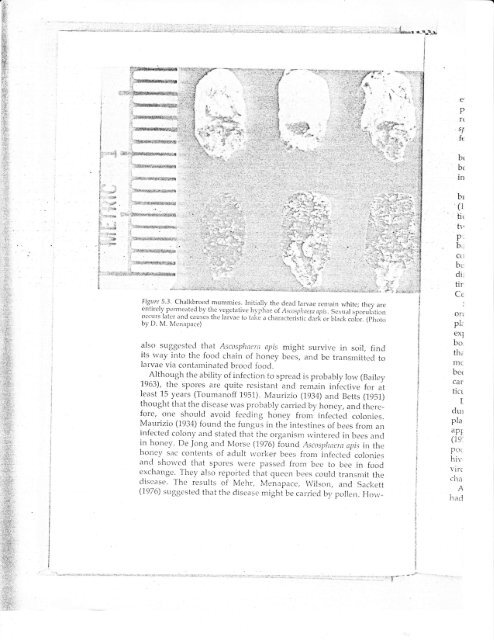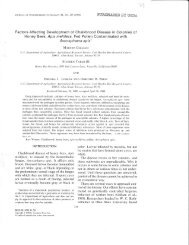Chalkbrood - Status Today and Hopes for Control' - Golden Rule Honey
Chalkbrood - Status Today and Hopes for Control' - Golden Rule Honey
Chalkbrood - Status Today and Hopes for Control' - Golden Rule Honey
You also want an ePaper? Increase the reach of your titles
YUMPU automatically turns print PDFs into web optimized ePapers that Google loves.
'#i:,'.<br />
f{d:,<br />
-L=*:<br />
". i<br />
Figure 5,3. <strong>Chalkbrood</strong> mummie_s.. Initiaily thedead rarvae remain white; they are<br />
entirely permeated by the vegetative hyphae of Ascosphneya apii- s."u"i'roorurition<br />
occurs later <strong>and</strong> causes the larvae to take a characteristic dari or black colcr. (photo<br />
by D. M. Menapace)<br />
also suggested that Ascasphoera npis might survive in soir, find<br />
its way into the food chain of honey bees, <strong>and</strong> be transrnitted to<br />
larvae via contaminated brood food.<br />
,A'lthough the ability of infection to spread is probably low (Bailey<br />
1963), the spores are quite resistantlnd remain inflctive <strong>for</strong> at<br />
least 15 years (Toumanoff 1951). Maurizio (1994) <strong>and</strong> Betts (1951)<br />
thought that the disease was probably carriecl by honey, <strong>and</strong> there<strong>for</strong>e,<br />
one should avoid feeding honey from infected colonies.<br />
Maurizio (1934) found the fungus in the intestines of bees from an<br />
infected colony <strong>and</strong> stated that the organism winterecl in bees <strong>and</strong><br />
in honey. De Jong <strong>and</strong> Morse (7926) found Ascosplwern apis in the<br />
honey sac contents of adult worker bees from infected colonies<br />
<strong>and</strong> shorl'ed that spores were passed from bee to bee in food<br />
exchange. They also repoited that queen bees could transmit the<br />
disease. The results of Mehr, Menapace, Wilson, <strong>and</strong> Sackett<br />
(1976) suggested that the disease mighi be carried by pollen. How_<br />
.e'<br />
P<br />
r(<br />
sl<br />
fe<br />
br<br />
'be<br />
in<br />
br<br />
(1<br />
tir<br />
tt'<br />
P':<br />
br,<br />
c(l<br />
be<br />
dir<br />
tir<br />
Ce<br />
1<br />
on<br />
pl;<br />
exl<br />
bo:<br />
th;<br />
mc<br />
bee<br />
car<br />
tict<br />
T<br />
dur<br />
pla<br />
apI<br />
(1e.<br />
por<br />
hiv,<br />
virc<br />
cha<br />
A<br />
hacl



